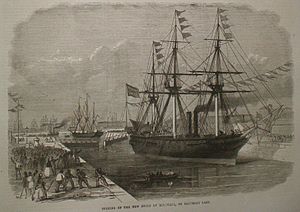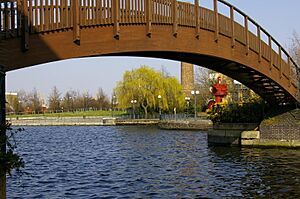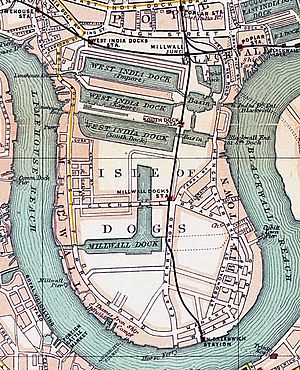Millwall Dock facts for kids
Quick facts for kids Millwall Dock |
|
|---|---|

Opening of new docks at Millwall in 1868
|
|
| Location | London |
| Built | 1802 |
| Built for | Built speculatively by John Kelk and John Aird & Co. |
| Architect | Sir John Fowler |
| Lua error in Module:Location_map at line 420: attempt to index field 'wikibase' (a nil value). | |
The Millwall Dock is a large dock found in Millwall, London, England. It is located south of Canary Wharf on the Isle of Dogs. Docks are places where ships can load and unload goods or passengers.
Contents
History of Millwall Dock

The Millwall Dock was a big project started by John Kelk and John Aird & Co.. They built it hoping it would be successful. The main engineer who designed the dock was Sir John Fowler.
The construction work was done by Kelk and Aird. The dock officially opened in March 1868. At first, the business had a slow start and faced money problems. Because of this, Kelk and Aird gave control of the company to the investors' lawyers in December 1868. To show that the business was now stable, it was renamed the Millwall Dock Company in 1870.
Dock Operations and Changes
From 1897 to 1921, the dock had its own train station, the Millwall Docks railway station. This station was part of the Millwall Extension Railway. Goods trains continued to use the railway until the 1970s.
In 1909, the Port of London Authority (PLA) took over the Millwall Dock. They also took control of other docks from St Katharines to Tilbury. This meant one big authority managed many of London's docks.
In the 1920s, the Port of London Authority made some changes. They connected the northern part of the Inner Dock to the West India Docks. This was done using a passage called the Millwall Passage.
The Millwall Dock was mainly used for timber (wood) and grain. Over time, this trade moved further down the river to the Port of Tilbury. A large grain terminal was built there in the 1960s. A flour mill called the Wheatsheaf Mill, built in 1869 by McDougall's, was located on the south side of the Outer Dock. It was taken down around 1980. The nearby Sir John McDougall Gardens is named after John McDougall, who was a local politician.
Decline and Modern Use
Starting in the 1960s, the Millwall Dock began to be used less and less. This happened to all of London's docks. The shipping industry started using containerisation, which means goods are packed into large metal boxes called containers. These containers were easier to handle at bigger, more modern ports like Tilbury. The Millwall Dock finally closed to commercial ships in 1981, along with the other Royal Docks.
Today, the area around the dock has changed a lot. The West Ferry Printing Works, which was a very large newspaper printing factory, was built on the north side of the Outer Dock between 1984 and 1986.
The Docklands Sailing and Watersports Centre was opened in 1989. It is located at the far west end of the dock. This center was created by the London Docklands Development Corporation and the Sports Council.
While many tall office buildings have been built in the area, Millwall Dock also has many homes. The Clippers Quay housing estate was built around the old dry dock in the 1980s. The Mill Quay housing development was built where the old Wheatsheaf Mill used to be.
The dock was even used for exciting boat stunts in the 1999 James Bond film The World Is Not Enough.
Layout of the Dock
The Millwall Dock has an L-shape. It has an 'Outer Dock' that runs from east to west. From the eastern end of the Outer Dock, an 'Inner Dock' runs north.
When it was first built, the dock had about 36 acres (14 hectares) of water. The whole area it covered was about 200 acres (81 hectares). The western end of the Outer Dock was originally connected to the Thames at Millwall. This connection was an 80-foot (24-meter) wide channel.
The dirt and earth dug out to create the docks formed a large area of land nearby. This area is now known as the Mudchute. A special dock for repairing ships, called a graving dock, was built at the south-east corner of the Outer Dock. It was later made longer to 555 feet (169 meters).



